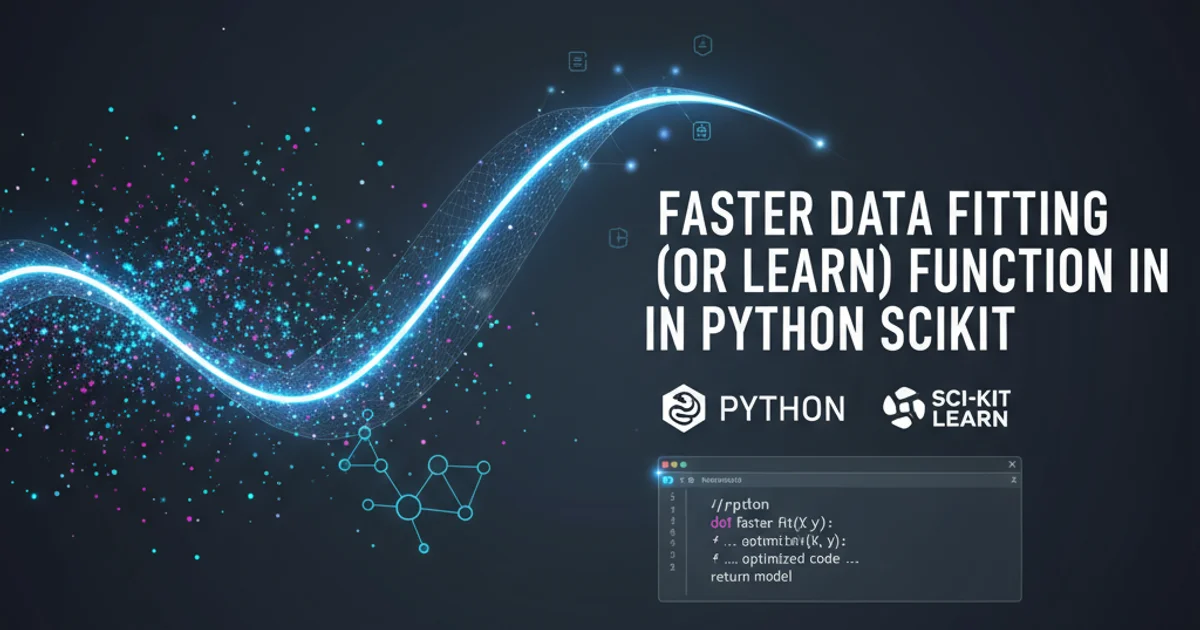faster data fitting ( or learn) function in python scikit
Categories:
Optimizing Data Fitting and Learning in Scikit-learn for Faster Performance

Discover advanced techniques and best practices to significantly speed up data fitting and model training processes in Python's scikit-learn library, enhancing efficiency for machine learning workflows.
In the realm of machine learning, especially with large datasets, the time taken to fit models can become a significant bottleneck. Scikit-learn, a powerful and widely used Python library, offers a robust set of tools for various machine learning tasks. However, without proper optimization, training times can escalate. This article delves into practical strategies and considerations to accelerate data fitting and learning functions within scikit-learn, ensuring your models train faster and more efficiently.
Understanding Performance Bottlenecks
Before optimizing, it's crucial to identify where the performance bottlenecks lie. Data preparation, feature engineering, model selection, and hyperparameter tuning all contribute to the overall training time. Often, the fitting process itself, especially for complex models or large datasets, consumes the most resources. Understanding the underlying algorithms and their computational complexity is key.
flowchart TD
A[Start ML Workflow] --> B{Data Loading & Preprocessing}
B --> C{Feature Engineering}
C --> D{Model Selection}
D --> E[Hyperparameter Tuning]
E --> F[Model Fitting/Training]
F --> G{Evaluation & Prediction}
G --> H[End ML Workflow]
subgraph Bottleneck Areas
B
C
E
F
endTypical Machine Learning Workflow and Potential Bottleneck Areas
Data Preprocessing and Feature Engineering Optimizations
Efficient data handling is the first step towards faster model fitting. Reducing data dimensionality, scaling features, and using sparse matrices when appropriate can dramatically cut down training times. Scikit-learn's preprocessing modules are highly optimized, but how you apply them matters.
import numpy as np
from sklearn.preprocessing import StandardScaler
from sklearn.decomposition import PCA
from scipy.sparse import csr_matrix
# Example: Scaling features
X = np.random.rand(10000, 100)
scaler = StandardScaler()
X_scaled = scaler.fit_transform(X)
# Example: Dimensionality Reduction
pca = PCA(n_components=50)
X_reduced = pca.fit_transform(X_scaled)
# Example: Using sparse matrices for sparse data
# Assuming X_sparse is a sparse dataset
# X_sparse = csr_matrix(X_sparse_data)
# model.fit(X_sparse, y)
Applying StandardScaler and PCA for data preprocessing
scipy.sparse matrices. Many scikit-learn estimators are optimized to handle sparse input efficiently, leading to significant memory and computational savings.Leveraging Parallel Processing and Model-Specific Optimizations
Scikit-learn offers several ways to leverage parallel processing, primarily through the n_jobs parameter found in many estimators and utilities like GridSearchCV. Setting n_jobs=-1 utilizes all available CPU cores. Additionally, some algorithms are inherently faster or have specific optimizations.
from sklearn.ensemble import RandomForestClassifier
from sklearn.model_selection import GridSearchCV
from sklearn.datasets import make_classification
# Generate synthetic data
X, y = make_classification(n_samples=10000, n_features=20, n_informative=10, n_redundant=5, random_state=42)
# Example: Using n_jobs for parallel processing in RandomForest
# -1 means use all available CPU cores
rf_classifier = RandomForestClassifier(n_estimators=100, n_jobs=-1, random_state=42)
rf_classifier.fit(X, y)
# Example: Using n_jobs in GridSearchCV for hyperparameter tuning
param_grid = {
'n_estimators': [50, 100],
'max_depth': [5, 10]
}
grid_search = GridSearchCV(RandomForestClassifier(random_state=42), param_grid, cv=3, n_jobs=-1)
grid_search.fit(X, y)
Utilizing n_jobs for parallel execution in RandomForest and GridSearchCV
n_jobs=-1 is often beneficial, it can sometimes lead to increased memory consumption. Monitor your system resources, especially with very large datasets or complex models, to avoid out-of-memory errors.Algorithm Choice and Hyperparameter Tuning Strategies
The choice of algorithm profoundly impacts training time. Simpler models like Logistic Regression or Linear SVMs are generally faster than complex ensemble methods or neural networks. When using more complex models, intelligent hyperparameter tuning can save significant time.
Instead of exhaustive grid search, consider randomized search (RandomizedSearchCV) or more advanced optimization techniques like Bayesian Optimization (e.g., using libraries like hyperopt or scikit-optimize). These methods explore the hyperparameter space more efficiently.
from sklearn.model_selection import RandomizedSearchCV
from sklearn.svm import SVC
from scipy.stats import uniform, randint
# Define parameter distributions for RandomizedSearchCV
param_distributions = {
'C': uniform(loc=0.1, scale=10),
'kernel': ['linear', 'rbf'],
'gamma': ['scale', 'auto']
}
# Initialize RandomizedSearchCV
# n_iter controls the number of parameter settings that are sampled
random_search = RandomizedSearchCV(SVC(random_state=42), param_distributions, n_iter=10, cv=3, n_jobs=-1, random_state=42)
random_search.fit(X, y)
Using RandomizedSearchCV for efficient hyperparameter tuning
SGDClassifier or SGDRegressor, which can fit models on mini-batches of data without loading the entire dataset into memory.